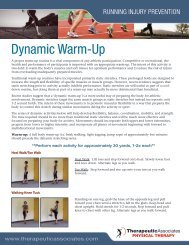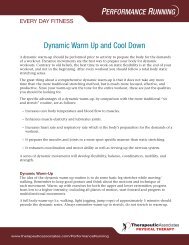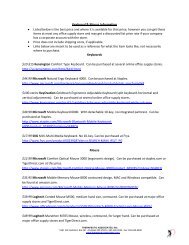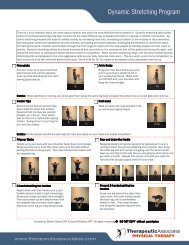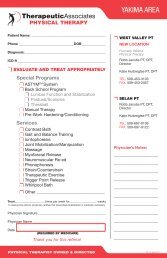Office Ergonomics Brochure (PDF) - Therapeutic Associates
Office Ergonomics Brochure (PDF) - Therapeutic Associates
Office Ergonomics Brochure (PDF) - Therapeutic Associates
You also want an ePaper? Increase the reach of your titles
YUMPU automatically turns print PDFs into web optimized ePapers that Google loves.
<strong>Office</strong> <strong>Ergonomics</strong><br />
Our Approach to Physical Therapy Embodies<br />
3 Principles that Encourage Good Health.<br />
Prevention:<br />
Strength<br />
Flexibility<br />
Rehabilitation:<br />
Physical Therapy<br />
Manual Therapy<br />
Management:<br />
Posture Training<br />
Proper Fitness Program<br />
“After making minor changes to my<br />
workstation, getting up from my desk<br />
every hour, and doing some simple<br />
exercises, I noticed a major difference<br />
in my productivity.”<br />
— Cindy Smith<br />
Customer Service Representative and Patient<br />
Exercise<br />
Sport Specific Training<br />
Biomechanical Gait Analysis<br />
Annual Physical Therapy<br />
Exam<br />
Pre-Surgery Program<br />
Workplace Design<br />
Ergonomic Consulting<br />
Stretch and Flex<br />
Sports Therapy<br />
Pain Management<br />
Inflammation Reduction<br />
Range of Motion Restoration<br />
Posture Retraining<br />
Core Strengthening<br />
Post-Surgery Rehab<br />
Return to Work Programs<br />
Education<br />
Post-Injury Training<br />
Sports<br />
Occupational<br />
Foot Orthotics<br />
Special Needs Population<br />
Arthritis<br />
Obesity<br />
Women’s Health<br />
Congenital Deformities<br />
Workstation Analysis<br />
Ergonomic Consulting<br />
P H Y S I C A L T H E R A P I S T O W N E D & D I R E C T E D<br />
O U R F O C U S I S Y O U .<br />
Since 1952<br />
www.therapeuticassociates.com
<strong>Therapeutic</strong> <strong>Associates</strong><br />
www.therapeuticassociates.com<br />
Your Workstation Set-up<br />
POSTURE For postural support, sit all the way<br />
back into the chair; knees should be slightly<br />
lower than hips with the seat tilted forward if<br />
possible; avoid twisting the neck and back; do<br />
not cross legs or shift weight to one side<br />
BACK Lumbar support should fit into the<br />
curve of your low back providing even<br />
pressure and support; back angle of the chair<br />
should be adjustable for occasional variations<br />
and should support the upper body in a vertical<br />
position<br />
SEAT Adjustable height and angle; firm<br />
cushion; “waterfall” front helps circulation<br />
to legs and feet; avoid sitting in a reclined<br />
position; try tilting the seat pan forward to<br />
achieve better seated posture<br />
DESK Work surface height should allow room<br />
to move legs and make postural adjustments;<br />
adjustable surface height preferable; If<br />
keyboard and mouse are on the desk, the<br />
work surface should be large enough to permit<br />
different positions of the monitor, keyboard<br />
and mouse<br />
FEET Entire sole should rest comfortably on<br />
the floor; Use a foot rest only if the desk height<br />
cannot be adjusted<br />
KEYBOARD Position horizontally or slightly<br />
declined, sloping away from the user; when<br />
hands are on the keyboard, forearms should<br />
be horizontal or sloping slightly downward;<br />
hands should be in line with the forearms so<br />
wrists are straight and fingers relaxed<br />
TELEPHONE Cradling telephone receiver<br />
between head and shoulder can cause muscle<br />
strain; using a headset allows head/neck to<br />
remain straight while keeping hands free<br />
MONITOR Eyes should be level with the top<br />
third of the screen; monitor should swivel<br />
horizontally and tilt vertically; place monitor<br />
in vertical position to decrease glare on the<br />
screen<br />
DOCUMENT HOLDER<br />
In line with the<br />
monitor and<br />
between the<br />
Stretch<br />
Comfortably<br />
monitor and<br />
keyboard<br />
without<br />
obstructing the<br />
monitor screen;<br />
correct placement allows the eyes to easily<br />
and naturally view the document without<br />
turning the head/neck<br />
Suggested Exercises<br />
Repeat each stretch frequently throughout the work day. Hold each<br />
stretch for at least 10 seconds. Stretches should be performed slowly<br />
and to the point where a gentle pulling/stretching sensation is felt.<br />
Chin Tucks<br />
Standing or sitting with good posture,<br />
look straight forward, tuck chin backward<br />
until gentle stretch is felt; chin<br />
should remain level during stretch.<br />
Wrist Extensor Stretch<br />
Starting with elbow straight, use<br />
the left hand to bend the right wrist<br />
forward until stretch is felt in the<br />
forearm. Repeat using the right hand<br />
to bend the left wrist.<br />
Chest/Bicep Stretch<br />
Lace fingers behind back and squeeze<br />
shoulder blades together. Slowly raise<br />
and straighten arms.<br />
Wrist Flexor Stretch<br />
Starting with elbow straight and palm<br />
facing up, use the opposite hand to<br />
bend the wrist and hand toward the<br />
floor until a stretch is felt in the forearm.<br />
Repeat with other hand.<br />
Prevent Injury<br />
Lower Back Stretch<br />
Place hands or thumbs on back of<br />
hips and lean backward while lifting<br />
chest.<br />
NECK AND UPPER BACK Stretch<br />
Clasp hands together in front with elbows<br />
extended. Gently reach forward,<br />
rounding upper back while bending<br />
head forward.<br />
Vary Tasks: Incorporate microbreaks, stretching and frequent changes in working posture.<br />
Avoid Eye StRain: Every 20 minutes rest eyes for 20 seconds by focusing on objects at least 20 feet away.<br />
Side Bend<br />
With one hand on hip to support trunk,<br />
bend toward the supported side while<br />
reaching overhead with opposite arm.<br />
Thumb Stretch<br />
SHOULDER Stretch<br />
Improve Strength<br />
and Flexibility<br />
With elbow straight and thumb side of wrist/hand toward<br />
ceiling, tuck thumb in fist and bend fist toward floor.<br />
Repeat with other hand.<br />
Reach right arm across the body<br />
toward left shoulder, using left hand to<br />
apply gentle pressure to the back of<br />
the right elbow. Relax and repeat with<br />
left arm.<br />
Conditions We Treat:<br />
Arthritis<br />
Carpal Tunnel Syndrome<br />
Headaches<br />
Leg Pain/Sciatica<br />
Low Back Pain<br />
Neck Sprain/Strain<br />
Post Surgical Rehab<br />
Shoulder Pain<br />
Tendinitis<br />
TMJ<br />
Work Related Injuries<br />
© 1999 VHI on all line illustrations




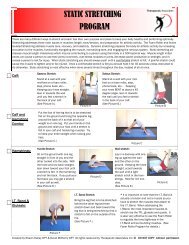
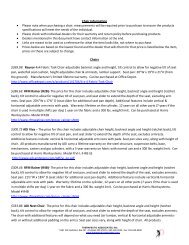
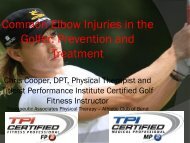
![[02] NAIOMT C-516 Cervical Spine I - Therapeutic Associates](https://img.yumpu.com/43449457/1/190x245/02-naiomt-c-516-cervical-spine-i-therapeutic-associates.jpg?quality=85)
